Are you looking for an easy way to make a custom table top? Putting together furniture can be a daunting task, but it doesn’t have to be! Glue up table tops are very popular and they give you the chance to create something unique and attractive. Glue-up table tops are relatively simple to construct, but it will take some time and patience in order to get results that look great and last.
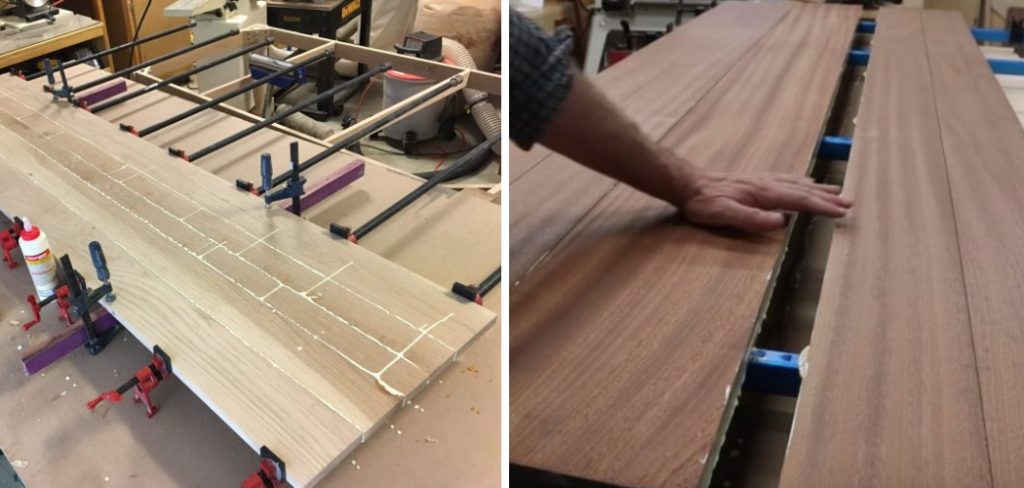
With just a few basic woodworking tools and supplies, you can easily create beautiful pieces of furniture for your home. This blog post will walk you through the process of glue-up construction step by step, from selecting your lumber to assembling the pieces into a strong tabletop gluing system. Read on for more information about how to glue up a table top.
What is a Glue-Up Table Top?
A glue-up table top is made by gluing together several pieces of wood to create one larger, solid piece. This technique is often used in woodworking to create tabletops, countertops, and other large surfaces. The process involves jointing the edges of each individual board and then gluing them together with strong wood glue.
Glue-up table tops can be made from a variety of wood types, including hardwoods like oak, maple, and cherry. You can also use softwoods such as pine or cedar for a more rustic look. The key is to select boards that have straight edges and minimal knots or other imperfections.
It’s important to note that glue-up table tops are not the same as solid wood pieces. While they may look similar, a solid wood piece is made from one continuous piece of wood, while a glue-up table top is made from several smaller pieces joined together.
Why Do You Need to Glue Up a Table Top?
1. Durable Surface
The primary reason for gluing up table tops is to give you a strong, durable surface that will last for years. As with any furniture build, the structural integrity of the piece is determined by the joint strength between two parts. A glue-up construction method ensures that your pieces are secured together tightly and securely. Glue-up tables also have the added benefit of allowing you to mix and match different woods for a unique look and feel.
2. Eliminates Gaps
Another great advantage of glue-up table tops is that the joints are much tighter than other methods of assembly, such as using screws or nails. This tight-fitting eliminates the need for filler material and ensures that your top is flush with no gaps.
3. Easy to Assemble
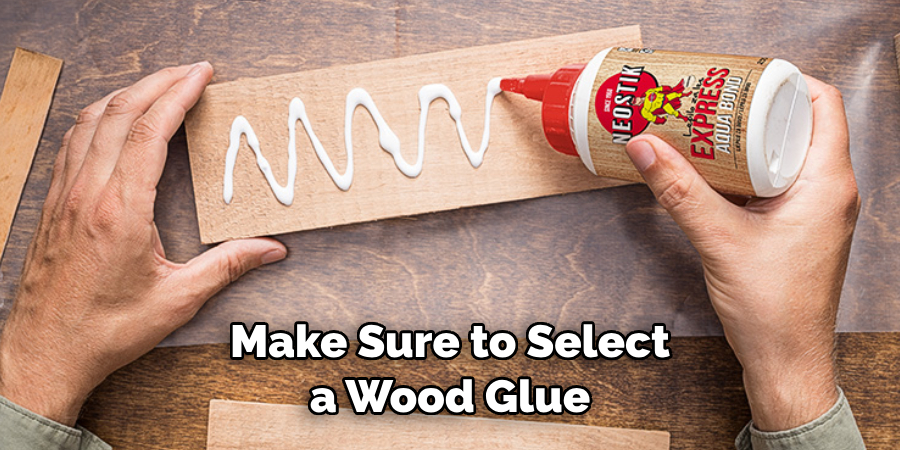
Glue-up table tops are also incredibly easy to assemble. All you need is some wood glue, clamps, and a few basic tools. With this simple setup, you can create sturdy furniture that looks great and is built to last.
Required Items
Before you can start building your glue-up tabletop, you will need a few items.
Wood Glue
This is the essential ingredient for any glue-up project. Make sure to select a wood glue that is suitable for outdoor use, so your table won’t be vulnerable to moisture and temperature changes.
Clamps
You will need several clamps to hold your pieces together while the glue dries. The type and size of clamp you use will depend on the size and shape of your tabletop, but it’s a good idea to have at least 3-4 available.
Sandpaper
Good quality sandpaper is essential for creating smooth edges on your tabletop.
Saw
Depending on the size of your tabletop, you may need to make some cuts in order to fit all of your pieces together. Make sure the saw you use is suitable for cutting wood. A circular saw or table saw are good options.
Planer
If you want your tabletop to have a flat surface, you may need to use a planer to smooth out any unevenness in the boards.
10 Instructions on How to Glue Up a Table Top
1. Gather Your Supplies
Before you get started, make sure you have all the supplies and tools you need for your project. You’ll need wood glue, clamps, saws, sandpaper or scrapers, pieces of wood for your tabletop, and any other materials you may need for your particular build.
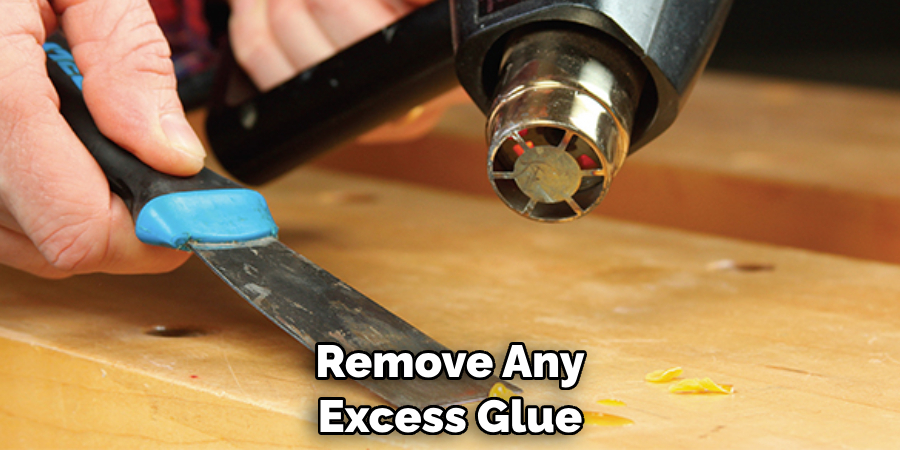
You should also have a suitable workspace set up with enough room to lay out your boards and maneuver around them. It’s also a good idea to have some protective covering on your workspace, such as a drop cloth or cardboard, to protect it from glue spills.
2. Cut Your Pieces to Size
Once you have all your supplies, it’s time to cut the wood pieces to size. You’ll want to make sure that each piece is cut accurately so that the table top fits together properly. If necessary, use sandpaper or scrapers to get a smooth, even finish. The smoother the edges, the better your joints will be. If you’re using a hardwood, make sure to use a sharp blade to minimize any splintering. The pieces should be cut to the exact dimensions you’d like your final tabletop to be.
It’s also a good idea to label each piece with a pencil or marker so you know which edge is the jointed edge and which side will be facing up.
3. Apply the Glue
Once all your pieces of wood are cut, it’s time to apply the wood glue. Make sure that you cover each piece evenly and thoroughly with glue to ensure a strong bond between each piece of wood. The glue should be applied to both surfaces before they are assembled. For best results, use a roller or brush to apply the glue evenly.
You should also work quickly as wood glue has a short drying time. If you have a large tabletop, work in sections to ensure that the glue doesn’t dry before you can clamp it together.
4. Assemble the Table Top
It’s time to assemble your tabletop! Start by placing one piece of wood onto the other and making sure that they fit together properly. Clamp them together tightly and make sure all pieces are pressed firmly against each other. Repeat this process until all pieces are joined together in a single large piece. Use a damp cloth to wipe away any excess glue that may have seeped out of the joints.
You can also use a scrap piece of wood and a hammer to tap the joints together for an even tighter fit. The joints should be flush and there should be no gaps between the pieces.
5. Remove Excess Glue
Once the table top is assembled, you’ll want to remove any excess glue that may have seeped out of the joints. Use a damp cloth or towel to wipe away the glue and let the table dry completely before proceeding. Do not use a wet cloth as this could reactivate the glue and weaken the joints.
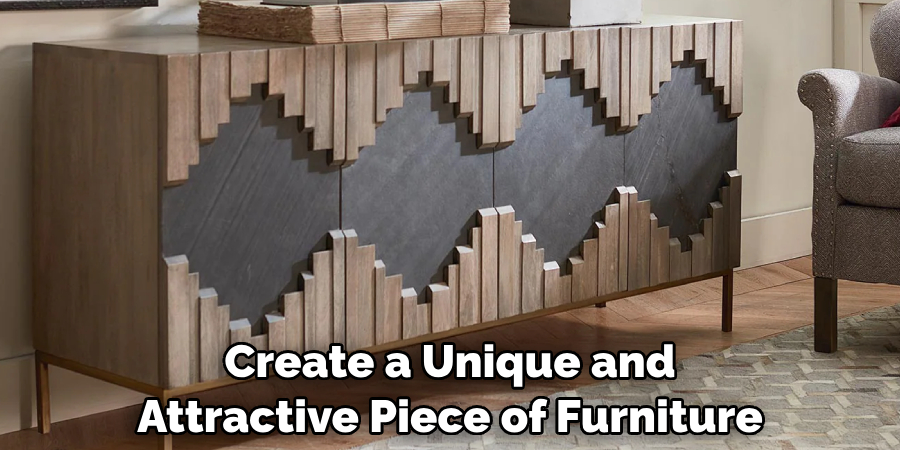
You can also use a scraper or chisel to remove any stubborn glue residue. It’s important to remove all excess glue before it dries, as it can be difficult to remove once hardened.
6. Sand Your Table Top
Using sandpaper, smooth down all surfaces of your tabletop until it is even and free of any blemishes. This will help your tabletop look more professional and ensure it lasts for years to come. You can also use a planer for larger surfaces to ensure that they are completely flat and level.
You can also sand the edges of your tabletop to create a more rounded or beveled edge, depending on your preference. It’s important to sand gently and evenly to avoid creating any uneven spots on the tabletop.
7. Apply Finish
Your tabletop is almost finished! Now, you’ll want to apply a finish of your choice in order to protect the wood from wear and tear. Be sure to follow the instructions on the product you choose and apply multiple coats for a durable finish. Allow the finish to dry completely before moving on to the next step.
You may also want to add paint or stain to your tabletop for a unique and customized look. It’s best to do this before applying the finish.
8. Let It Dry
Once the finish has been applied, let your tabletop dry for at least 24 hours before using it. This will give the finish time to cure and ensure that it is strong and durable. Drying time will vary depending on the finish you choose and the humidity levels. Be sure to check the instructions on your chosen finish for specific drying times.
The longer you let your tabletop dry, the stronger and more durable it will be in the long run. But be patient; it will be worth the wait!
9. Clean off the Residue
Once your tabletop is dry, you’ll want to clean off any excess residue that may have built up during the process. Use a soft cloth to gently remove any dust or dirt that has accumulated on the surface of your tabletop.
You may also want to apply a final coat of finish or wax for added protection and shine. It’s important to regularly clean and maintain your tabletop to ensure it stays in good condition.
10. Enjoy Your Table Top
Your glue-up table top is now finished! All that’s left to do is enjoy your newly created furniture. Congrats on a job well done! With these steps, you can now transform any piece of wood into a beautiful and strong table top. Use your new skills to create custom pieces for your home or even sell them to others. The possibilities are endless with a strong and well-crafted table top. Happy building!
By following these simple instructions, you can easily create a unique and attractive piece of furniture for your home. With the right supplies and a bit of patience, you can create beautiful glued-up table tops that are sure to impress.
8 Maintenance Tips
Gluing up a table top can be an intimidating task, but with the proper preparation and techniques, it can be completed successfully. Here are eight tips for maintaining and caring for your gluing-up project:
1. Proper Clamping is needed. Use enough clamps to ensure that the glue is properly distributed across all areas of the joint. Make sure to double-check that the clamps are tight and all surfaces are under pressure.
2. Cleansers can be used to remove any dirt, dust, or other debris from the wood before beginning the gluing process. Always make sure to use a non-toxic cleanser. A cleaner can also help remove glue and other buildups after the gluing process.
3. Using high-quality glue will make sure that your joints are strong and durable. Make sure you follow the instructions on the packaging and apply it evenly across all surfaces. The glue should never be applied when it is too cold.
4. The joint should be clamped together as soon as the glue has been applied. This will ensure that the bond between the pieces of wood is strong and secure. Make sure the pressure is even along all surfaces for a successful joint.
5. Avoid Glue. Squeeze Out as much as possible. You can use a damp cloth to wipe away any excess glue while it is still wet. If you do end up with some squeeze-out, make sure to clean it off immediately and allow the joint to dry completely before joining.
6. Glue should be allowed to cure for at least 24 hours before using the tabletop or applying any finishes. Letting the glue dry completely will ensure that the bond is strong and will not break easily.
7. Make sure to inspect your tabletop regularly for any signs of separation or loosening in the joints. Applying a bit of glue along the edges can help you maintain a tight bond and prevent any further damage.
8. Finally, make sure to keep all woodworking tools and materials away from children and pets to ensure everyone’s safety. Glue can be dangerous if not handled properly.
Following these tips will help you maintain your tabletop gluing project so it lasts for many years to come. With proper preparation and care, a successful tabletop gluing project can be achieved!
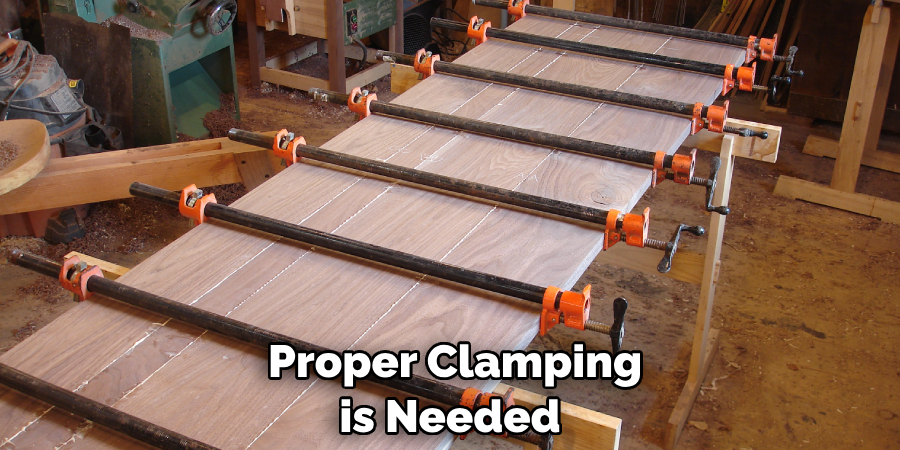
Frequently Asked Questions
Q: Can I Use Any Type of Wood for a Tabletop Gluing Project?
A: Yes, you can use any type of wood as long as it is properly prepared and sanded before gluing. However, certain woods, such as maple and birch, are better for tabletops due to their durability and strength. The choice ultimately depends on personal preference and the intended use of the tabletop.
Q: How Many Clamps Should I Use for a Tabletop Gluing Project?
A: It is recommended to use at least one clamp per foot of the joint. This will ensure even pressure and a strong bond between the pieces of wood. However, the number of clamps needed may vary depending on the size and shape of your tabletop. It’s always better to have too many clamps than not enough.
Q: How Important is Sanding in a Tabletop Gluing Project?
A: Sanding is a crucial step in any woodworking project, especially in a tabletop gluing project. It helps create a smooth and even surface for the glue to adhere to, resulting in a stronger bond between the wood pieces. But make sure to sand in the direction of the wood grain for best results.
Q: Can I Apply Stain or Paint Before Gluing?
A: It is best to apply any paint or stain before gluing as it will be easier to cover all surfaces and edges. This will also prevent the finish from getting onto the glue, which can affect the bond between the wood pieces. But if you do choose to apply a finish after gluing, make sure to wait for at least 24 hours for the glue to cure completely.
Conclusion
In conclusion, properly gluing up a tabletop is essential to the overall look and feel of any furniture-making project. By assessing the materials needed and understanding the approach, anybody can successfully glue up a tabletop without the risk of peeling or buckling in future use. Due to its importance, be sure to practice gluing techniques with scrap wood so that it can be done efficiently and with satisfactory results for each individual project.
Also, safety precautions should always be taken while working with adhesives. With this information, it’s time to put your newfound knowledge into action, go forth and create those incredible tables! Follow the steps on how to glue up a table top to make sure that each glue-up job is done right for a tabletop that will last for years.

